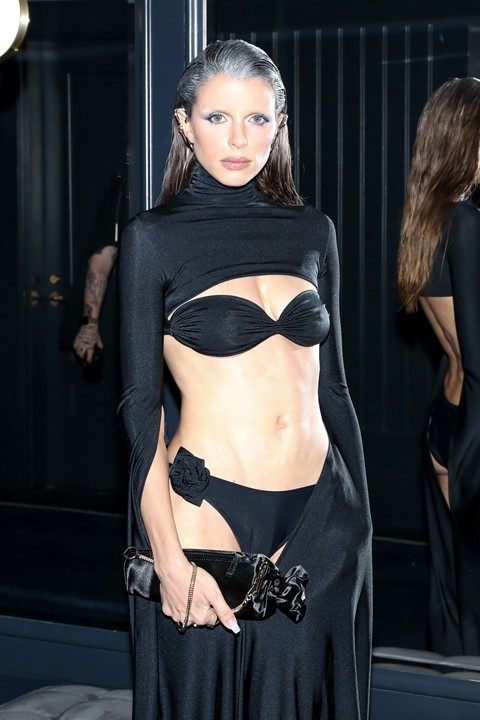Messages about embracing ageing are important and valuable, but what type of ageing are we being asked to embrace, and who gets left behind?
“Ageing is fully in. Like, fully.” That’s Julia Fox’s latest forecast. After sporting grey hair last week at the CFDA Awards as a “love letter to getting older,” the 32-year-old took to TikTok to continue her pro-ageing advocacy. “If I see another product that says anti-ageing on the label, I’m suing.” Like the rest of us, Fox is fed up with the anti-ageing industrial complex and how beauty corporations continue to profit from women’s insecurities around ageing.
Fox herself is not immune to these pressures, having in the past admitted to having “preemptive” Botox and as recently as September was a spokesperson for Xeomin, a Botox alternative. It’s understandable from someone who inhabits an industry that so intensely perpetuates fear and shame around ageing and womanhood. But now she is speaking out and asking women to embrace ageing; on a surface level, that’s a beautiful and valuable message. But what type of ageing are we really being asked to embrace, and who gets left behind?
In 2019, British Vogue and L’Oréal released a special edition magazine dedicated to women over 50. Actress and activist Jane Fonda graced the cover as the face of effortless ageing; at 81, Fonda was still attractive (after a lifetime of plastic surgeries) and active (in both career and fitness). Similarly, actress Andie MacDowell appeared on the cover of Vogue Poland in 2021, discussing how she’s never felt more beautiful than she does at 63. MacDowell performed yoga poses in platform heels in the photoshoot, highlighting her good health and physical ability.
Most recently, Jennifer Aniston sparked an ageing debate with her December cover of Allure, where she showed off her abs in a Chanel S/S96 micro bikini top. Like MacDowell, Aniston asserts that she feels the best about who she is today at 53 than she ever did in her 20s or 30s. She is talking about her mental well-being, about being in a place of acceptance after years of fertility struggles. But it’s hard to ignore the physical changes that have taken place to give her a more youthful appearance. The ageing may have been “successful”, but it’s not been naturally achieved.
Fonda, MacDowell and Aniston (at the time of their covers) represented what academics call ‘successful’ ageing. Coined by psychologists John Rowe and Robert Louis Kahn, the concept is defined as being: free from disability or disease, having high physical and cognitive functioning, and an active social (or professional) life. While these women will attribute their success in ageing to working out and eating well, it all comes down to their access to wealth, which directly impacts their quality of life. When magazines ‘celebrate’ ageing, they’re not really lauding it at all. Instead, they’re celebrating ageing people’s proximity to the social indicators of youth (health, beauty and physical mobility); they’re celebrating people’s “victories” over ageing.
“I love seeing older women grace magazine covers and TV screens, but it’s not lost on me that they’re still a glossy, unachievable representation of the ageing process,” says Cassie Powney, former beauty editor of Cosmopolitan. “Jennifer clearly wanted to tell the world: ‘I may be talking about my failed IVF here, but I can still pose in next-to-nothing with the confidence of a 20-year-old supermodel – that, is successful ageing.’ Did it feel positive for the women her age who don’t still have pert boobs, a glossy mane, and taut, bronze skin? I’m sure it conjured up a mixed bag of emotions, from empowerment right through to inadequacy.”
@juliafox Ooooo I know this is gonna make the broke boys mad #OLDISIN ♬ original sound - Julia fox
If certain people can age successfully, who ages unsuccessfully? Dr Michael Toze, senior lecturer in Public Health at the Lincoln Medical School, writes that according to this framework, disabled people, people of colour, LGBTQ+ people and poor people do not age successfully. “Socially marginalised populations are often affected by ‘minority stress’: [they are more prone to] poor health associated with experiences of prejudice and exclusion.” The successful ageing model is not only ableist but completely unattainable for most. Yet it’s the narrative of ageing we are asked to embrace and work towards time and time again.
When the onus of responsibility on how to age well is placed on the individual – which is precisely what the successful ageing model does – we erase the government’s responsibility to care for and support the elderly and disabled. In March, the Centre for Ageing Better released its annual State of Ageing Report, reporting that England has become an increasingly challenging country to grow old in, with pensioner poverty and levels of poor health increasing. The UK state pension has been called ‘one of the worst in Europe’, with 200,000 people of pension age falling into poverty in the last year.
Ageing is a privilege we are encouraged to see as a problem, so learning to embrace the inevitable is important. However, we must be critical of the type of ageing we are asked to accept uncritically. The kind of ageing that is fixated on beauty, prioritises individualism over community care (or a literal National Care Service) and suggests that disability is a failure.
Join Dazed Club and be part of our world! You get exclusive access to events, parties, festivals and our editors, as well as a free subscription to Dazed for a year. Join for £5/month today.




